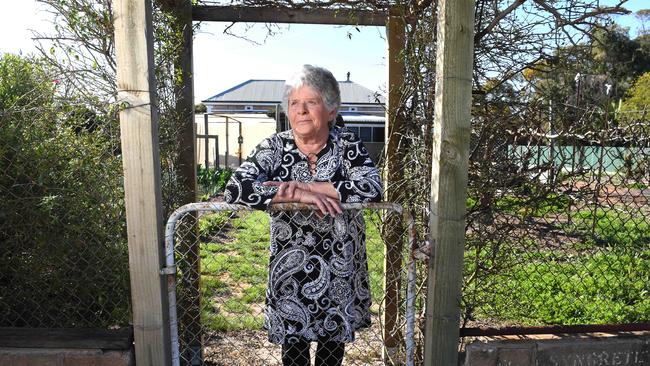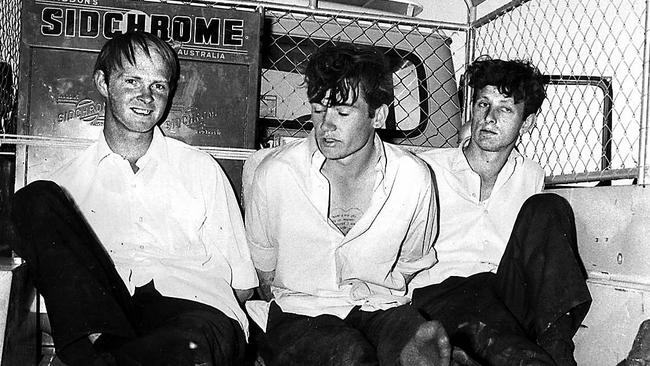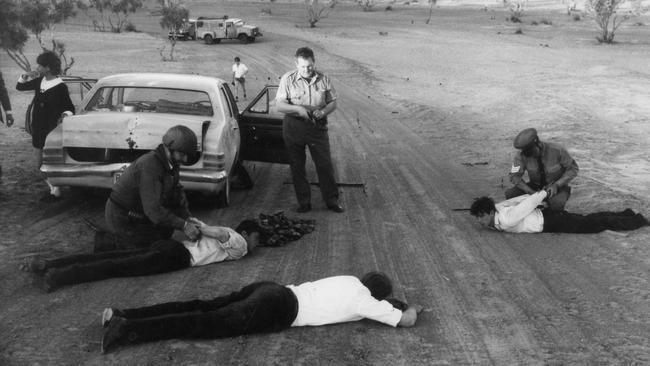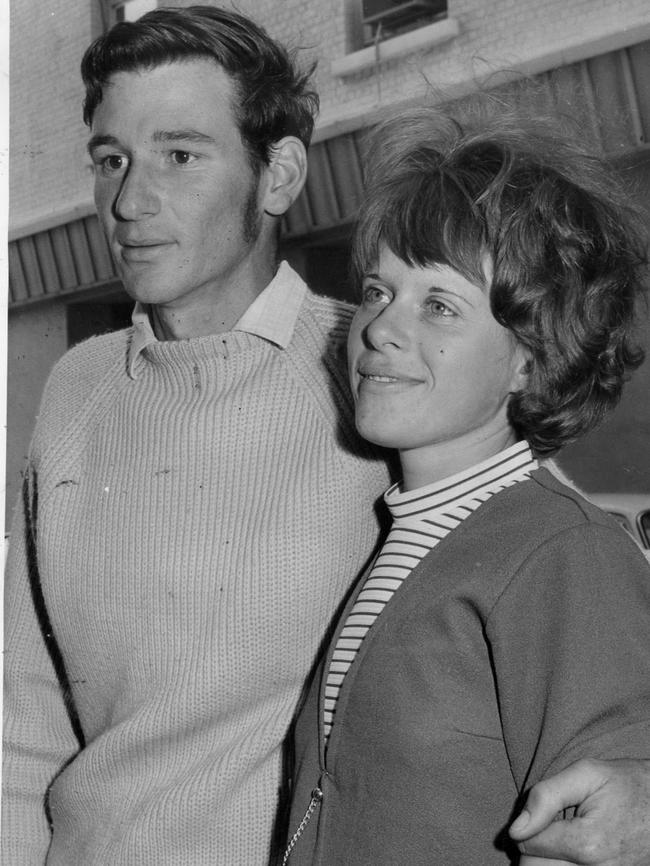Monica Smith recalls 26-hour journey with three Cadell prison escapees, 50 years after violent kidnapping
She was enjoying a cold beer with her family when three prisoners walked through the kitchen door and violently abducted her. Five decades on, the Sunday Mail revisits Monica Smith’s incredible tale of survival and its extraordinary intersection with one Adelaide photographer.

True Crime
Don't miss out on the headlines from True Crime. Followed categories will be added to My News.
Inside a charming farmhouse hidden away in the Riverland scrub, three men armed with sticks kidnapped a young woman enjoying a cold afternoon beer with her family.
The incident was 50 years ago today but Monica Smith (nee Schiller), now 71, still bears the trauma of her journey with three escaped prisoners that lasted 26 sleepless hours.
She was just finishing a hard day’s work on the farm with her boyfriend Graham Smith when Terrence Haley, Murray Andrew Brooks and Raymond Clifford Gunning escaped from Cadell Training Centre, about 10km directly north of her property.
The couple returned to the farmhouse for a cool drink with Mrs Smith’s parents, blissfully unaware of the horrors about to walk through their unlocked kitchen door.
Five decades on, sitting in her old bedroom where her mum and dad were once tied up to an organ, Mrs Smith recalls the day three convicts senselessly terrorised her family.
“It was a heck of a shock – you read about these things in newspapers and magazines but at the time I couldn’t believe it was happening,” Mrs Smith tells the Sunday Mail.
She married Graham just 12 months after the kidnapping and has lived in the same house ever since, save for a few years at Padthaway in the mid-1970s.

Mrs Smith now spends her time gardening, wheat cropping and looking after sheep and chickens on their modest farm, just off Oxford Landing Road.
Her bedroom has since been converted into a living room, where a 3000-piece safari jigsaw puzzle is sprawled over a table in the middle – a project of her husband’s, she says.
Sitting on a couch where her bed once was, Mrs Smith casts her mind back 50 years, just after her 21st birthday.
“They tied up Mum and Dad in here and Graham up in the sleep-out,” she says. “There used to be a bed out there and they tied him to that.”
Meanwhile, her deaf grandmother staying in a small cottage on the property had no idea what had transpired in the main house.
The men ordered Mrs Smith to pack clothes while they ransacked the house, stealing a transistor radio, a jar of cash, one of Mr Smith’s suits and even young Monica’s personal diary. “And then of course, Dad had his guns over in the shed so they grabbed every one of them,” she says.
“Dad must have had some ammunition over there as well.”
Haley, Brooks and Gunning – all in their early 20s at the time – were serving time for burglary and were within months of release before making a bizarre escape from the low-security prison.
Cadell Training Centre spans 1600ha of land with grazing grounds, a dairy farm and picturesque orange orchards. Prisoners work several hours a day on the grounds while taking part in vocational training, preparing them for release.
Similar to 1970, today it keeps only offenders who are towards the end of their sentences and have demonstrated good behaviour.

At Mrs Smith’s property, Haley, Brooks and Gunning stole her dad’s car and bundled her in the back seat with her family still tied up inside.
She recalls the men driving erratically to Murbko, a few minutes west of her property, where one local in their front garden recognised the car and waved.
“I actually waved back and they shoved me down,” she says. “They pushed me down so they were hoping they wouldn’t recognise that I was in there. They had pinched my transistor radio at the time and they had switched it on, listening for any news on what had transpired.”
Back at the property, Mr Smith managed to free himself and run to a neighbour 1km away to raise the alarm.
Eventually ending up in the Adelaide beachside suburb of Semaphore, Mrs Smith and the trio stopped to buy food and soft drinks, before making a dash back up north.
Meanwhile, now-retired photographer Ray Titus, of now-defunct evening newspaper The News, along with a police reporter, were following leads around Semaphore, while his wife Coral was due to give birth to twins.
“In those days, the husband didn’t go to the birth,” Titus says.
He went to work about 6am on Monday, when his chief of staff said the escapees had been sighted at Jamestown. His boss hired a light plane and rang police, offering a spare seat to Detective Sergeant Bob “Hugger” Giles, armed with a rifle.

“I said ‘I can’t go’, I said ‘Coral is having twins today’,” Titus remembers.
After being convinced he would be “back by lunchtime”, he agreed to go on the job – and following a fuel stop at Leigh Creek, Titus received some news.
“I think I was sort of dozing off or something in the back of the plane when I heard them say over the speaker, ‘Tell Titus he’s had twin boys’,” he recalls.
“I thought, ‘s..t that’s all right’. Then Hugger Giles was getting reports from police the prisoners had been breaking into service stations and they were up the Birdsville Track.”
Mrs Smith cannot remember the trio’s exact objectives while they drove but recalls them talking about heading to Queensland.
They dumped her father’s car near Quorn and stole another vehicle before heading towards Birdsville, just past SA’s border with Queensland.
Mrs Smith says she “didn’t dare sleep” during the ordeal, which she claims escalated when Haley allegedly sexually assaulted her in the back seat of the car while the other two men sat in the front.
“They didn’t sort of rough me up or anything, but (Haley) tried to have sex,” she says. “He was stopped, just because of the circumstances.”
None of the men was charged with sex offences.

While she hides her trauma behind a veil of Outback stoicism, Mrs Smith agrees the kidnapping changed her. “It did change how we lived because we were locking everything and making sure all the vehicles were locked,” she says. “It did change us.
“It’s sort of put a bit of a dampener on things (but) there’s no turning back.
“There’s no use dwelling on the past really – you just got to move on and get on with life.
“I just shrug it off these days. I mean, after all, it’s 50 years ago.”
Mrs Smith says there were several opportunities for them to kill her over the 26-hour ordeal.
“I thought if it was going to happen, it could’ve happened when Brooks and myself went for a walk,” she says.
“Well, he made me go with him and Haley and the other fella were back at the car and they had the guns.
“They could have taken a pot shot quite easily.”
Haley, Brooks and Gunning stopped at several truck stops in their travels, raiding them of cans of food and supplies.
Soon after, the plane with Titus and Detective Sergeant Giles flew overhead.
“It was after lunch some time we buzzed this property and we saw this car under a tree,” Titus recalls.
“We sort of buzzed it, and sure enough, a bloody rifle came out the window pointed at us. I don’t know whether it fired, but it was definitely pointing at the plane.”
At that point, the trio sped off north, while the plane landed about 250km ahead of them at Birdsville.
Detective Sergeant Giles and Titus got into two Land Rovers, courtesy of Queensland Police, and headed back south to intercept the car.
The prisoners spent a short time bogged in the sand near a farm but eventually drove straight towards waiting police. “One of them got out and ran back over the hill,” Titus recalls.
“We stopped there and then Hugger Giles was running and I was up behind him.”’
One of the men used a rifle to open fire at the detective.
“You could see the bullets, the sand was moving, I was s..tting myself,” Titus says.
“I thought ‘Bloody hell, I’ve never been in a gunfight before’.
“Maybe six, seven, eight bullets were firing and then Hugger just stopped, propped himself and then fired two shots.”
Detective Sergeant Giles had purposely missed the target, forcing the prisoner to drop his gun.
Meanwhile, one of the men who ran over the hill turned around and surrendered.
“They were all handcuffed, put in the car and within 10 minutes it was dark,” Titus says. “It was unbelievable.
“Another 10 minutes and this would never have happened,” he says of his Walkley Award-winning photograph of the arrest.
“They might have arrested them but you would never have got those pictures.”


Mrs Smith still remembers the “absolute relief” of seeing Detective Sergeant Giles’s face. “Hooray, I’m saved,” she says. “That was the best thing ever, that’s for sure.”
Detective Sergeant Giles, who died in 2006, attended Monica and Graham’s wedding in 1971.
Mrs Smith intends to organise a reunion with other officers involved in the rescue, including legendary detective Allen Arthur.
After the rescue, she spent the night at Birdsville Hospital before flying back home with Detective Sergeant Giles and Titus.
The story didn’t end there, however – at least not for Titus.
He vividly remembers the moment his heart sank after landing at Adelaide Airport.
“I looked out the plane and saw my father and Coral’s brother out there and I thought ‘Jeez, I wonder what they’re doing out there’,” he says.
“When I got out of the plane, they said one of the twins passed away with breathing problems. I had gone from excitement to drama, back to disappointment.”
The surviving twin, Greg, is “as good as gold” and turns 50 today.
Haley received 15 years’ imprisonment for the kidnapping but escaped again in 1972.
He then served eight years in a NSW jail before being extradited back to SA, where he was released on parole in 1986. Brooks and Gunning were jailed for 12½ and 11½ years respectively.

In 1989, Haley was shot in the back while at home, lying on his lounge. He was later charged with attempted murder over another shooting that same night in Campbelltown. The charges were replaced with manslaughter and then dropped.
Mrs Smith worked at a vineyard near Cadell for 30 years and had two children with Mr Smith. Sadly, their son Roger took his own life on Boxing Day 2001, leaving behind two daughters of his own.
Now, 50 years since she was violently abducted, she still feels she was robbed of her innocence at a time she was meant to be enjoying life the most. But she has not let the dramatic events get in the way of leading a rich existence.
Last year, she and her husband embarked on a European river cruise, seeing all the sights of Budapest, Amsterdam, Paris, Berlin and more.
“Two years before that, we did a tour of Czech Republic and Poland,” she says. “My ancestors originated from Poland but, unfortunately, we don’t have any record of family members who are still alive there.”
Her fridge is covered in magnets collected from her favourite travel destinations over the years and she takes pride in being a dedicated member of the local church women’s group and Waikerie Gardening Club.
The pain of losing her son in 2001 still runs deep but she finds comfort in her religion and her happy marriage with Mr Smith.
And she still has a long list of home DIY jobs to get through, including repainting the living room and deep-cleaning the carpet.
gabriel.polychronis@news.com.au
Originally published as Monica Smith recalls 26-hour journey with three Cadell prison escapees, 50 years after violent kidnapping

